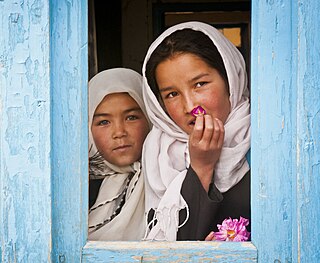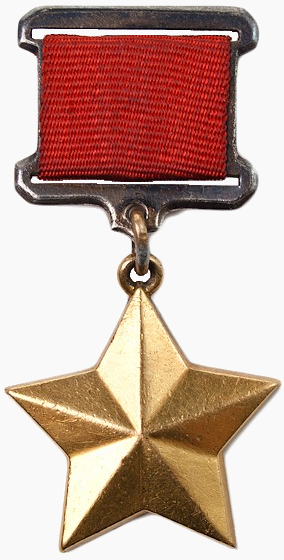
The Hazaras are an ethnic group and a principal component of Afghanistan’s population. They are one of the largest ethnic groups in Afghanistan, primarily residing in the Hazaristan (Hazarajat) region in central Afghanistan. Hazaras also form significant minority communities in Pakistan, mainly in Quetta, and in Iran, primarily in Mashhad. They speak the Dari and Hazaragi dialects of Persian. Dari, also known as Dari Persian, is one of the two official languages of Afghanistan.

The Democratic Republic of Afghanistan, later known as the Republic of Afghanistan, was the Afghan state between 1978 and 1992. It was bordered by Pakistan to the east and south, by Iran to the west, by the Soviet Union to the north, and by China to the northeast. Established by the People's Democratic Party of Afghanistan (PDPA) following the Saur Revolution in April 1978, it came to rely heavily on the Soviet Union for financial and military assistance and was therefore widely considered to be a Soviet satellite state. The PDPA's rise to power is seen as the beginning of the ongoing Afghan conflict, and the majority of the country's years in existence were marked by the Soviet–Afghan War. It collapsed by the end of the First Afghan Civil War in April 1992, having lasted only four months after the dissolution of the Soviet Union.

The title Hero of the Soviet Union was the highest distinction in the Soviet Union, awarded together with the Order of Lenin personally or collectively for heroic feats in service to the Soviet state and society. The title was awarded both to civilian and military persons.

The prime minister of Afghanistan, officially the prime minister of the Islamic Emirate of Afghanistan, is the head of government of Afghanistan.

Hero of the Russian Federation, also unofficially called Hero of Russia, is the highest honorary title of the Russian Federation. The title has a Gold Star medal, an insignia of honour that identifies recipients.

Major general Georgi Ivanov Kakalov is a Bulgarian former military officer who was the first Bulgarian cosmonaut. He was a member of the National Assembly of Bulgaria in 1990.

Valeri Vladimirovich Polyakov was a Soviet and Russian cosmonaut. He is the record holder for the longest single stay in space, staying aboard the Mir space station for more than 14 months during one trip. His combined space experience was more than 22 months.

Vladimir Afanasyevich Lyakhov was a Ukrainian Soviet cosmonaut.

The Ministry of Interior Affairs is the cabinet ministry of Afghanistan responsible for law enforcement, civil order and fighting crime. The ministry's headquarters is located in Kabul.

National Olympic Committee of the Islamic Republic of Afghanistan, unrecognizably known as General Directorate of Olympics, Physical Education and Sports during Taliban takeover, formerly known as Afghanistan National Olympic Committee, is the National Olympic Committee representing Afghanistan. The Committee is currently in exile and presided by Hafizullah Wali Rahimi, while International Olympic Committee (IOC) has not recognized the Taliban regime's Committee since 2021.

The Republic of Afghanistan was the first republic in Afghanistan. It is often called the Daoud Republic, as it was established in July 1973 after General Sardar Mohammad Daoud Khan of the Barakzai dynasty alongside senior Barakzai Princes deposed his cousin, King Mohammad Zahir Shah, in a coup d'état. The occasion for the coup was the 1964 Constitution of Afghanistan which took power from most members of the royal family in favour of centralization under Zahir Shah and his offspring under the tenet of democracy. Daoud Khan was known for his autocracy and attempts to modernize the country with help from both the Soviet Union and the United States, among others.

The 1973 Afghan coup d'état, also called by Afghans as the Coup of 26 Saratan and self-proclaimed as the Revolution of 26 Saratan 1352, was led by Army General and prince Mohammad Daoud Khan against his cousin, King Mohammad Zahir Shah, on 17 July 1973, which resulted in the establishment of the Republic of Afghanistan under a one-party system led by Daoud Khan.
The Afghan Tazkira is an official national identity document issued to every national and citizen of Afghanistan, including a member of the Afghan diaspora around the world.

The Afghan Armed Forces, officially the Armed Forces of the Islamic Emirate of Afghanistan and also referred to as the Islamic Emirate Armed Forces, is the military of Afghanistan, commanded by the Taliban government from 1997 to 2001 and since August 2021. According to Afghanistan's Ministry of Defense, its total manpower is 170,000.

Sanaullah Ghafari, better known under his nom de guerre, Shahab al-Muhajir is an Afghan militant who is serving as the Emir of the Islamic State's Khorasan Province (ISIS–K) since 2020.

The Order of the Red Star Tomsk Artillery School is a military educational institution founded on 3 January 1920, which trained officers for the Artillery Troops. It was disbanded on 23 August 1965 and the Tomsk Higher Military Command School of Communications was created on its basis.

The Armed Forces of the Democratic Republic of Afghanistan, known as the Armed Forces of the Republic of Afghanistan after 1986, was the national military of Afghanistan from 1978 to 1992.
Nazar Muhammad (1935–1998) was a Colonel General in the Afghan Armed Forces, the Commander-in-Chief of the Afghan Air Force, the former Minister of Defense as well as the Chief of General Staff before 1988, being replaced by Shahnawaz Tanai. He was born in 1935 in Shindand District, Herat in the Kingdom of Afghanistan and died in 1998, Quetta, Pakistan. He was the former ambassador to West Germany.
Faiz Muhammad was an Afghan military officer and politician. He served in several governmental posts in Afghanistan during the 1970s and early 1980s, serving as Minister of Interior from 1973 to 1975 and as Minister of Borders and Tribal Affairs In 1980, and also served as the Afghan ambassador to Indonesia and Iraq.
The 226th Zemlyansky Infantry Regiment was an infantry regiment of the Imperial Russian Army. The unit existed from 1914 to 1918. The regiment was famous for defending Osowiec Fortress, having carried out the "Attack of the Dead Men."















